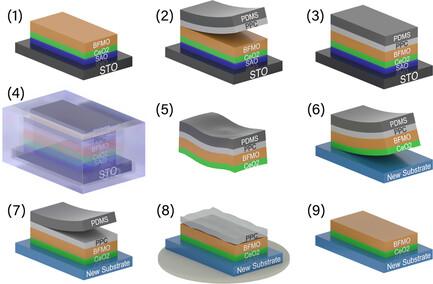Large Area Transfer of Bismuth-Based Layered Oxide Thin Films Using a Flexible Polymer Transfer Method
IF 11.1
Q1 MATERIALS SCIENCE, MULTIDISCIPLINARY
引用次数: 0
Abstract
Magnetic and ferroelectric oxide thin films have long been studied for their applications in electronics, optics, and sensors. The properties of these oxide thin films are highly dependent on the film growth quality and conditions. To maximize the film quality, epitaxial oxide thin films are frequently grown on single-crystal oxide substrates such as strontium titanate (SrTiO3) and lanthanum aluminate (LaAlO3) to satisfy lattice matching and minimize defect formation. However, these single-crystal oxide substrates cannot readily be used in practical applications due to their high cost, limited availability, and small wafer sizes. One leading solution to this challenge is film transfer. In this demonstration, a material from a new class of multiferroic oxides is selected, namely bismuth-based layered oxides, for the transfer. A water-soluble sacrificial layer of Sr3Al2O6 is inserted between the oxide substrate and the film, enabling the release of the film from the original substrate onto a polymer support layer. The films are transferred onto new substrates of silicon and lithium niobate (LiNbO3) and the polymer layer is removed. These substrates allow for the future design of electronic and optical devices as well as sensors using this new group of multiferroic layered oxide films.

利用柔性聚合物转移法实现铋基层状氧化物薄膜的大面积转移
长期以来,人们一直在研究磁性和铁电氧化物薄膜在电子、光学和传感器中的应用。这些氧化物薄膜的特性在很大程度上取决于薄膜的生长质量和条件。为了最大限度地提高薄膜质量,外延氧化物薄膜通常生长在钛酸锶(SrTiO3)和铝酸镧(LaAlO3)等单晶氧化物基底上,以满足晶格匹配并最大限度地减少缺陷的形成。然而,这些单晶氧化物基底由于成本高、供应有限和晶圆尺寸小,无法在实际应用中轻易使用。薄膜转移是解决这一难题的主要方法之一。在本演示中,我们选择了一类新型多铁性氧化物材料,即铋基层状氧化物,用于薄膜转移。在氧化物基底和薄膜之间插入一层水溶性 Sr3Al2O6 牺牲层,使薄膜从原始基底释放到聚合物支撑层上。薄膜被转移到新的硅和铌酸锂(LiNbO3)基底上,然后移除聚合物层。利用这些基底,未来可设计出使用这组新型多铁性层状氧化物薄膜的电子和光学设备以及传感器。
本文章由计算机程序翻译,如有差异,请以英文原文为准。
求助全文
约1分钟内获得全文
求助全文
来源期刊
CiteScore
14.00
自引率
2.40%
发文量
0
期刊介绍:
Small Science is a premium multidisciplinary open access journal dedicated to publishing impactful research from all areas of nanoscience and nanotechnology. It features interdisciplinary original research and focused review articles on relevant topics. The journal covers design, characterization, mechanism, technology, and application of micro-/nanoscale structures and systems in various fields including physics, chemistry, materials science, engineering, environmental science, life science, biology, and medicine. It welcomes innovative interdisciplinary research and its readership includes professionals from academia and industry in fields such as chemistry, physics, materials science, biology, engineering, and environmental and analytical science. Small Science is indexed and abstracted in CAS, DOAJ, Clarivate Analytics, ProQuest Central, Publicly Available Content Database, Science Database, SCOPUS, and Web of Science.

 求助内容:
求助内容: 应助结果提醒方式:
应助结果提醒方式:


